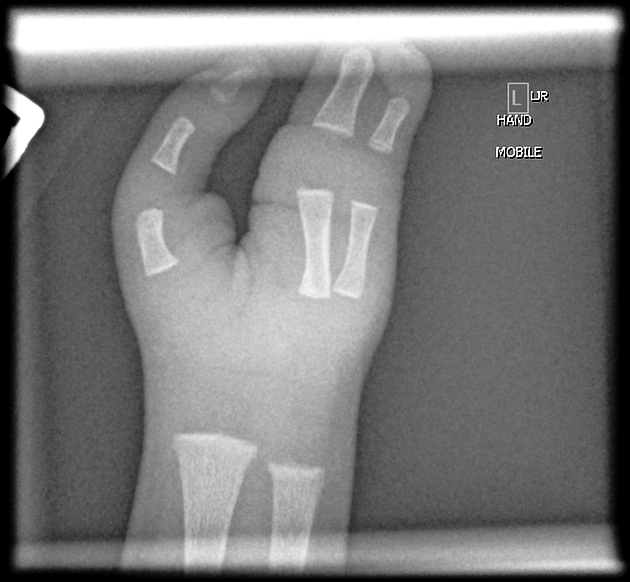Ectrodactyly-ectrodermal dysplasia-clefting syndrome
Last revised by James Harvey
on 25 Jun 2020
Citation, DOI, disclosures and article data
Citation:
Harvey J, Knipe H, Jones J, et al. Ectrodactyly-ectrodermal dysplasia-clefting syndrome. Reference article, Radiopaedia.org (Accessed on 20 Feb 2025) https://doi.org/10.53347/rID-17180
Permalink:
rID:
17180
Article created:
Disclosures:
At the time the article was created Yuranga Weerakkody had no recorded disclosures.
View Yuranga Weerakkody's current disclosures
Last revised:
25 Jun 2020,
James Harvey
Disclosures:
At the time the article was last revised James Harvey had no recorded disclosures.
View James Harvey's current disclosures
Revisions:
4 times, by
4 contributors -
see full revision history and disclosures
Systems:
Sections:
Synonyms:
- EEC syndrome
- Ectrodactyly-ectrodermal dysplasia-clefting (EEC) syndrome
Ectrodactyly-ectrodermal dysplasia-clefting (EEC) syndrome is a rare genetic syndrome that has high clinical variability but typically comprises of the triad of
- ectrodactyly +/- syndactyly 1 +/- polydactyly 5
- ectrodermal dysplasia
- facial clefts: cleft lip and/or palate
Pathology
Genetics
It is thought to carry an autosomal dominant inheritance.
Associations
- congenital genitourinary anomalies 1
References
- 1. Allen LM, Maestri MJ. Three-dimensional sonographic findings associated with ectrodactyly ectodermal dysplasia clefting syndrome. J Ultrasound Med. 2008;27 (1): 149-54. J Ultrasound Med (full text) - Pubmed citation
- 2. Nyberg DA, McGahan JP. Diagnostic imaging of fetal anomalies. Philadelphia : Lippincott Williams & Wilkins, 2003. (2003) ISBN:0781732115. Read it at Google Books - Find it at Amazon
- 3. Maizels M, Cuneo BF, Sabbagha RE. Fetal anomalies, ultrasound diagnosis and postnatal management. John Wiley and Sons. (2002) ISBN:0471380520. Read it at Google Books - Find it at Amazon
- 4. Entezami M, Albig M, Knoll U et-al. Ultrasound Diagnosis of Fetal Anomalies. Thieme. (2003) ISBN:1588902129. Read it at Google Books - Find it at Amazon
- 5. Annerén G, Andersson T, Lindgren PG et-al. Ectrodactyly-ectodermal dysplasia-clefting syndrome (EEC): the clinical variation and prenatal diagnosis. Clin. Genet. 1991;40 (4): 257-62. - Pubmed citation
- 6. Rodini ES, Richieri-costa A. EEC syndrome: report on 20 new patients, clinical and genetic considerations. Am. J. Med. Genet. 1990;37 (1): 42-53. doi:10.1002/ajmg.1320370112 - Pubmed citation





 Unable to process the form. Check for errors and try again.
Unable to process the form. Check for errors and try again.